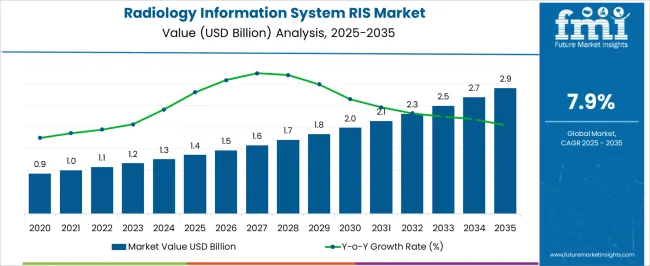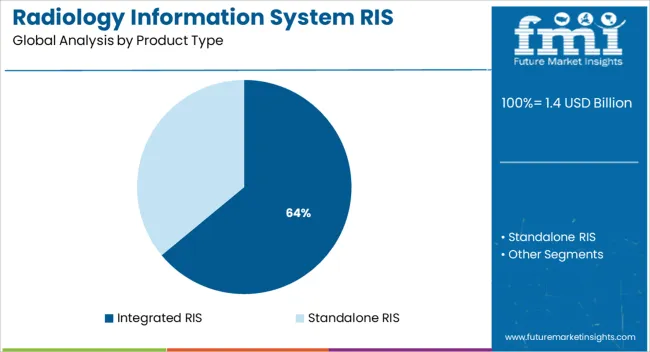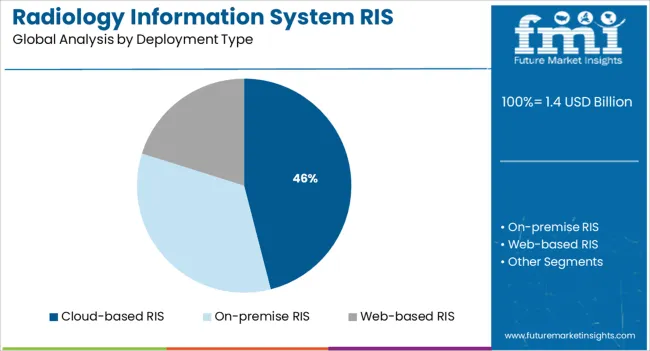The Radiology Information System RIS Market is estimated to be valued at USD 1.4 billion in 2025 and is projected to reach USD 2.9 billion by 2035, registering a compound annual growth rate (CAGR) of 7.9% over the forecast period.

| Metric | Value |
|---|---|
| Radiology Information System RIS Market Estimated Value in (2025 E) | USD 1.4 billion |
| Radiology Information System RIS Market Forecast Value in (2035 F) | USD 2.9 billion |
| Forecast CAGR (2025 to 2035) | 7.9% |
The radiology information system (RIS) market is witnessing significant momentum, driven by the need for centralized data management, enhanced diagnostic workflows, and integration across radiology departments. Increased patient volumes, rising imaging complexity, and the demand for faster diagnosis are encouraging healthcare providers to adopt more scalable and interoperable systems.
Integration with hospital information systems (HIS), picture archiving and communication systems (PACS), and electronic health records (EHR) has become a strategic focus to streamline radiology operations. Healthcare digitization initiatives, value-based care models, and compliance with regulatory standards like HIPAA and GDPR are further propelling investment in modern RIS platforms.
Looking ahead, increased penetration of cloud infrastructure, AI-driven diagnostic support, and remote imaging access are anticipated to open new growth avenues, especially in underserved and multi-location clinical settings.
The market is segmented by Product Type and Deployment Type and region. By Product Type, the market is divided into Integrated RIS and Standalone RIS. In terms of Deployment Type, the market is classified into Cloud-based RIS, On-premise RIS, and Web-based RIS. Regionally, the market is classified into North America, Latin America, Western Europe, Eastern Europe, Balkan & Baltic Countries, Russia & Belarus, Central Asia, East Asia, South Asia & Pacific, and the Middle East & Africa.

Integrated RIS is projected to account for 64.0% of the total revenue share in 2025, making it the leading product type in the market. This segment’s dominance is being driven by its ability to unify radiology data with other clinical and administrative systems, improving coordination across departments.
Integrated systems reduce manual data entry, minimize diagnostic delays, and enable real-time communication between radiologists, technicians, and referring physicians. Enhanced workflow automation, including scheduling, reporting, and billing, supports hospital-wide efficiency gains.
As institutions increasingly prioritize end-to-end interoperability and regulatory compliance, integrated RIS platforms are being widely adopted for their role in optimizing clinical outcomes and administrative productivity.

Cloud-based RIS is anticipated to hold 46.0% of the overall market revenue by 2025, establishing it as the most rapidly expanding deployment segment. Its adoption is being fueled by scalability, cost-efficiency, and the ability to facilitate remote access to imaging data and reports.
Cloud-based systems minimize the need for on-premise IT infrastructure, offering flexibility for healthcare providers operating across multiple sites or rural areas. Enhanced cybersecurity protocols, automated backups, and real-time software updates have addressed earlier concerns about data security and system reliability.
The shift toward tele-radiology and collaborative diagnostics has further supported demand for cloud-based platforms, which enable seamless data exchange, reduce turnaround time, and support 24/7 radiology services.
The rising prevalence of chronic diseases including cancer, arthritis, cardiovascular disease, and diabetes as a result of increased fast food consumption and sedentary lifestyles is one of the key reasons propelling the market.
The market for radiology information systems is anticipated to expand as a result of the aging population's rapid growth, which has led to a surge in chronic diseases. Additionally, the market for diagnostic services, including those related to medical imaging, is growing quickly. As a result, there is an urgent need for healthcare products and services that are inexpensive, quick, and efficient.
Furthermore, the expansion of radiology information system applications is anticipated to accelerate market expansion. The benefits of minimally invasive treatments are becoming more widely known, which is expected to fuel market expansion.
In comparison to other regions, North America has the greatest market for radiology information system sales and makes the most contribution. This is a result of the diagnostic industry's growing demand for better, quicker, and more useful outcomes.
Due to increasing investments in healthcare facilities, as well as the rising demand for the diagnosis and treatment of chronic diseases, East Asia is predicted to have the fastest-growing demand for radiology information systems. Through several joint ventures as well as mergers and acquisitions, China had made significant investments in Australia's healthcare system, which in turn had a favorable impact on the region's market of radiology information systems.
Some of the market players operating in the radiology information system RIS market are Siemens Healthcare GmbH, Carestream Health, McKesson Corporation, Cerner Corporation, General Electric Company (GE Healthcare), IBM Watson Health, Allscripts Healthcare, LLC, Epic Systems Corporation, Hologic, Inc., MedInformatix, Inc., and others.
| Report Attributes | Details |
|---|---|
| Growth Rate | CAGR of 7.9% 2025 to 2035 |
| Base Year for Estimation | 2024 |
| Historical Data | 2012 to 2024 |
| Forecast Period | 2025 to 2035 |
| Qualitative Units | Revenue in USD Billion, and CAGR from 2025 to 2035 |
| Report Coverage | Revenue Forecast, Company Ranking, Competitive Landscape, Growth Factors, Trends, and Pricing Analysis |
| Segment Covered | Product, Deployment, Region |
| Region Covered | North America; Latin America; Europe; East Asia; South Asia; Oceania; Middle East Africa (MEA) |
| Key Countries Profiled | The USA, Canada, Brazil, Mexico, Germany, The UK, France, Spain, Italy, China, Japan, South Korea, Malaysia, Singapore, Australia, New Zealand, GCC, South Africa, Israel |
| Key Players | Siemens Healthcare GmbH; Carestream Health; McKesson Corporation; Cerner Corporation; General Electric Company (GE Healthcare); IBM Watson Health; Allscripts Healthcare, LLC; Epic Systems Corporation; Hologic, Inc.; MedInformatix, Inc. |
| Customization | Available Upon Request |
The global radiology information system RIS market is estimated to be valued at USD 1.4 billion in 2025.
The market size for the radiology information system RIS market is projected to reach USD 2.9 billion by 2035.
The radiology information system RIS market is expected to grow at a 7.9% CAGR between 2025 and 2035.
The key product types in radiology information system RIS market are integrated ris and standalone ris.
In terms of deployment type, cloud-based ris segment to command 46.0% share in the radiology information system RIS market in 2025.






Full Research Suite comprises of:
Market outlook & trends analysis
Interviews & case studies
Strategic recommendations
Vendor profiles & capabilities analysis
5-year forecasts
8 regions and 60+ country-level data splits
Market segment data splits
12 months of continuous data updates
DELIVERED AS:
PDF EXCEL ONLINE
AI Radiology Tool Market Insights – Growth, Demand & Forecast 2024-2034
Teleradiology Market Analysis - Size, Share, and Forecast Outlook 2025 to 2035
Teleradiology Services Market Growth - Trends & Forecast 2025 to 2035
Autonomous Radiology Systems Market Size and Share Forecast Outlook 2025 to 2035
Interventional Radiology Product Market Size and Share Forecast Outlook 2025 to 2035
Interventional Radiology Market Growth - Trends & Forecast 2025 to 2035
Nonvascular Interventional Radiology Device Market Trends – Growth & Forecast 2024-2034
Information Security Consulting Market
Weather Information Technology Market Analysis - Growth & Forecast through 2034
Product Information Management Market Growth – Trends & Forecast 2024-2034
Student Information System Market
Airport Information Display System Market
Building Information Modeling Market Size and Share Forecast Outlook 2025 to 2035
Building Information Management (BIM) Market Analysis – Trends & Forecast 2024-2034
Security Information and Event Management Software Market
Oncology Information Systems Market Analysis - Trends & Forecast 2025 to 2035
Clinical Information System Market Analysis - Growth & Forecast 2024 to 2034
Hospital Information System Market
Regulatory Information Management Market Size and Forecast Outlook 2025 to 2035
Enterprise Information Archiving (EIA) Market Size and Share Forecast Outlook 2025 to 2035

Thank you!
You will receive an email from our Business Development Manager. Please be sure to check your SPAM/JUNK folder too.
Chat With
MaRIA